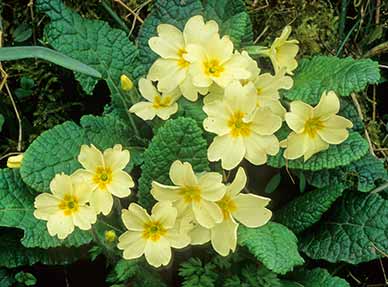Primrose (Primula vulgaris)
When: Best seen from mid-March to May
How many: Relatively widespread, but rarely abundant

Primroses are always a joy to behold. In bloom from March to May, they could quite justifiably be described as harbingers of spring. In fact, the 'Primula' part of the scientific name derives from two Latin words: prima rosa or 'first rose'. (Vulgaris means 'common').
Nowhere in the New Forest are primroses common, however - grazing deer and commoners' animals see to that. And for the same reason, luxurious growth is rare, which simply serves to enhance the delight whenever these attractive plants are encountered.
Found primarily as scattered individuals in lightly grazed, broad-leaved woodland inclosures and at woodland / heathland edges, primroses boast an array of five-petalled, notched, subtly coloured, pale yellow flowers, darker in the centre and borne singly on each stem.
Remarkably, primrose flowers have evolved two different arrangements of reproductive organs, one known as 'pin-eyed' and the other as 'thrum-eyed', that prevent self-fertilisation and the consequent restriction of the gene pool. ('Pin-eyed' flowers have a long, pin-like female stigma visible at their centre with, out of sight, male stamens attached part way down; whilst 'thrum-eyed' flowers have a hidden, short stigma and a ring of longer, protruding, clearly visible stamens. Visiting insects can pollinate flowers of different types, but not flowers of the same type, thus effectively ensuring cross-fertilisation).
Sticky seeds are eventually produced that, in another of nature's clever processes, are taken, and thereby dispersed, by ants attracted to the food source stored within them. Many of the flowers, though, appear too early in the year to attract insects and some, maybe many, go unpollinated. Indeed, William Shakespeare in 'The Winter's Tale' referred to 'pale primroses that die unmarried'.
Herbalists and others in days-gone-by used all parts of the plant to produce their seemingly magic potions. John Gerard in the late 16th century, for example, noted: 'The roots of primrose stamped and strained, and the juice sniffed into the nose with a quill or such like, purgeth the brain, and qualifieth the pain of the megrim' - a severe headache or migraine; whilst the leaves and flowers, boiled and mixed with rose and betony waters, sugar, pepper, salt and butter, were taken as part of a wider cure for phrensie - a type of mental derangement.
Cowslips (Primula veris), close relatives of the primrose, also occur in the New Forest, but are rarely encountered - they usually prefer relatively lime-rich soils that are infrequently found locally, other than following importation for use around, for example, some of the old airfields.
References:
The Encyclopedia of British Wild Flowers: John Akeroyd
The Englishman’s Flora: Geoffrey Grigson
The Herball or General Historie of Plantes: John Gerard
Field Guide to the Wild Flowers of Britain: various contributors
The Private Life of Plants: David Attenborough
More links
Other related links
Search this site

Sadly, 58 animals were killed - 35 ponies, 13 cows, 8 donkeys and 2 sheep, whilst a further 32 were injured - 3 pigs, 9 donkeys, 11 cows and 9 ponies.
(Forty-three accidents occurred in daylight, 15 at twilight and 101 in the dark. Twenty-seven accidents were not reported by the driver involved).
Here's just one horrific example - Three donkeys killed in collision with van at notorious New Forest blackspot (Advertiser and Times)

